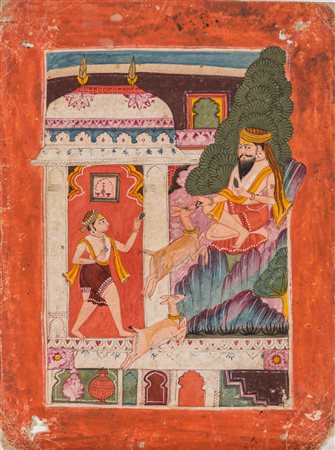 Capitolium Art - Via Carlo Cattaneo 55, 25121 Brescia
Capitolium Art - Via Carlo Cattaneo 55, 25121 Brescia
ASTA 217 - FINE CHINESE, ISLAMIC & ASIAN ART 3A TORNATA
Thursday 15 June 2017 hours 18:00 (UTC +01:00)
An important miniature from a Ragamala India, South-West Rajasthan, Sirohi,...
An important miniature from a Ragamala India, South-West Rajasthan, Sirohi, 1680 ca. . Cm 17,00 x 22,70. The Ragamala is a series of paintings depicting musical modes, and representing one of the themes most dear to the Indian tradition, especially the Rajasthani one. Each series comprises 36 or, more rarely 42, paintings, grouped in families of six members which include a raga (male) and five raginis (wives). Considering the complexity of this structure, a complete series is very hard to find, but harder still is finding Ragamala belonging to the Sirohi school, of which are known at the moment only a complete series of 36 paintings and another of 13, part of the K. Sangram Singh collection in Nawalgarh, in addition to various single paintings part of public and private collections, and a series of thirteen paintings which recently gained the attention of academics, and from which come the two articles on offer (present lot and the next). The Sirohi painting school was active for around two centuries, XVII - XVIII, but the period in which most Ragamala paintings were made was the end of the XVII century, to which belong all of the pieces known. It is widely agreed that the distinctive characteristics of this school lie in the brilliance of the colors and, especially as far as Ragamala are concerned, in the interpretation of the themes and classical Rajasthani iconography with a local accent, traits which make the Sirohi school unique among the Rajputi painting schools. This painting depicts Sarang Raga, as written in the text on the verso of the folio, where an ascetic seats on a rock next to a tree while two deers are running towards him and a young disciple is approaching. They both carry leaves to feed the animals. All natural elements are set in a courtly location. For reference please see Victoria and Albert Museum, London (IS. 113-1960) and for further information refer to the article Elena Preda, The Sirohi Ragamalas: an important Discovery, in Rivista degli Studi Orientali, 2011, volume LXXXIV, pp. 371-383.






